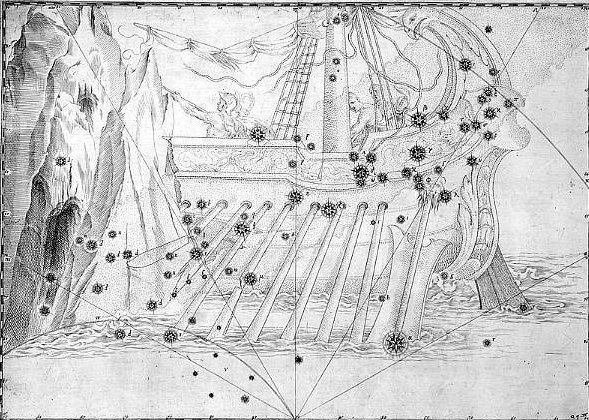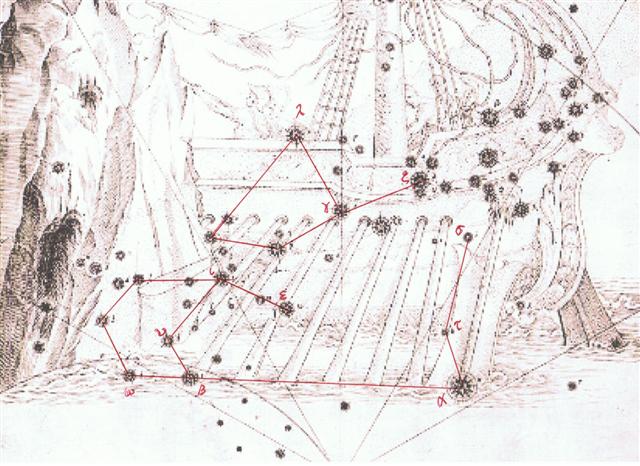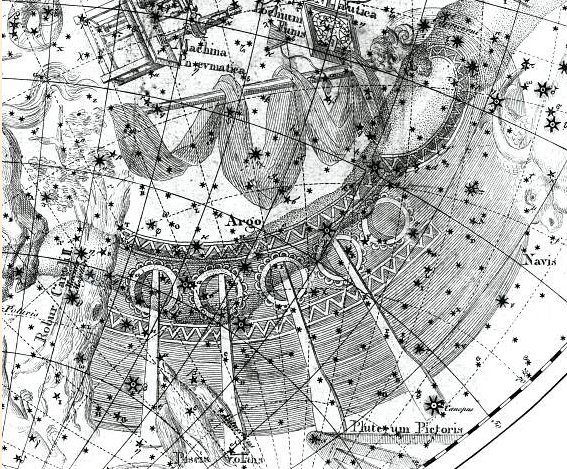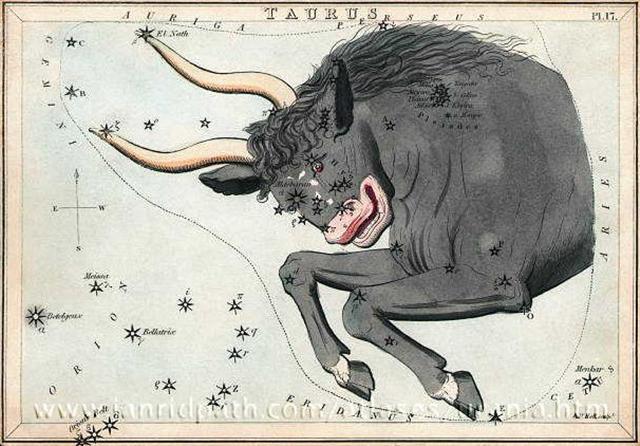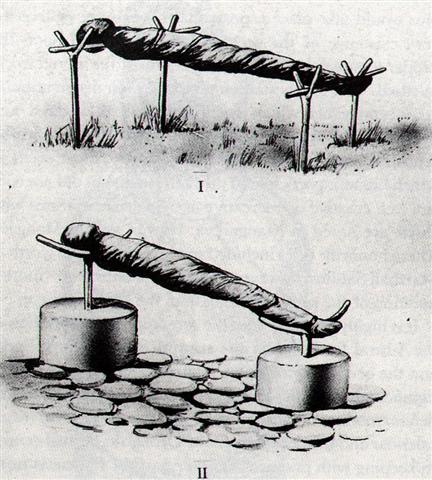My idea of a connection between the great banyan tree (with a hole) and a mountain (with a hole) is supported by other illustrations of Argo Navis:
"Whatever Johann Bayer’s Uranographia of 1603 may have lacked in strict positional accuracy it more than made up for in artistic merit. Here the Argo is seen passing between the Clashing Rocks at the mouth of the Black Sea. Bayer depicts some of the ship's oars splintering on the rocks, and the yard arm with the furled sail also appears to have snapped. The brilliant star Canopus lies on the blade of the portside steering oar, as described by Ptolemy." (Ian Ridpath's site.)
"Argo Navis dominates this crowded scene in the southern celestial hemisphere in the Uranographia of Johann Bode (1801). On the blade of one of the steering oars lies the bright star Canopus, now part of the constellation Carina. The prow of the ship was usually imagined as disappearing between the Clashing Rocks or vanishing into the mists of the Milky Way, but here the rocks are replaced by Charles’s Oak (Robur Caroli II), a now-obsolete constellation invented by Edmond Halley. Unlike other depictions of Argo, this version has no main mast rising from the body of the ship. The spar around which the sail is wrapped appears to emerge from the stern ..." (Ian Ridpath's site.) "The Symplegades ... or Clashing Rocks, also known as the Cyanean Rocks, were, according to Greek mythology, a pair of rocks at the Bosphorus that clashed together randomly. They were defeated by Jason and the Argonauts, who would have been lost and killed by the rocks except for Phineus' advice. Jason let a dove fly between the rocks; it lost only its tail feathers. The Argonauts rowed mightily to get through and lost only part of the stern ornament. After that, the Symplegades stopped moving permanently." (Wikipedia) This dangerous hole could be connected with fire: ... A man had a daughter who possessed a wonderful bow and arrow, with which she was able to bring down everything she wanted. But she was lazy and was constantly sleeping. At this her father was angry and said: 'Do not be always sleeping, but take thy bow and shoot at the navel of the ocean, so that we may get fire.' The navel of the ocean was a vast whirlpool in which sticks for making fire by friction were drifting about. At that time men were still without fire. Now the maiden seized her bow, shot into the navel of the ocean, and the material for fire-rubbing sprang ashore. Then the old man was glad. He kindled a large fire, and as he wanted to keep it to himself, he built a house with a door which snapped up and down like jaws and killed everybody that wanted to get in. But the people knew that he was in possession of fire, and the stag determined to steal it for them. He took resinous wood, split it and stuck the splinters in his hair. Then he lashed two boats together, covered them with planks, danced and sang on them, and so he came to the old man's house. He sang: 'O, I go and will fetch the fire.' The old man's daughter heard him singing, and said to her father: 'O, let the stranger come into the house; he sings and dances so beautifully.' The stag landed and drew near the door, singing and dancing, and at the same time sprang to the door and made as if he wanted to enter the house. Then the door snapped to, without however touching him. But while it was again opening, he sprang quickly into the house. Here he seated himself at the fire, as if he wanted to dry himself, and continued singing. At the same time he let his head bend forward over the fire, so that he became quite sooty, and at last the splinters in his hair took fire. Then he sprang out, ran off and brought the fire to the people ... It was a dark time when the people had no fire and perhaps they resided (noho) in a time of rain (te vai): ... They walked in crowds when they arrived at Tulan, and there was no fire. Only those with Tohil had it: this was the tribe whose god was first to generate fire. How it was generated is not clear. Their fire was already burning when Jaguar Quitze and Jaguar Night first saw it: 'Alas! Fire has not yet become ours. We'll die from the cold', they said. And then Tohil spoke: 'Do not grieve. You will have your own even when the fire you're talking about has been lost', Tohil told them. 'Aren't you a true god! Our sustenance and our support! Our god!' they said when they gave thanks for what Tohil had said. 'Very well, in truth, I am your god: so be it. I am your lord: so be it,' the penitents and sacrificers were told by Tohil. And this was the warming of the tribes. They were pleased by their fire. After that a great downpour began, which cut short the fire of the tribes. And hail fell thickly on all the tribes, and their fires were put out by the hail. Their fires didn't start up again. So then Jaguar Quitze and Jaguar Night asked for their fire again: 'Tohil, we'll be finished off by the cold', they told Tohil. 'Well, do not grive', said Tohil. Then he started a fire. He pivoted inside his sandal ...
The kava glyph, when Heka was a nakshatra star, is drawn like a broken tree - the elbow illustrating the 'break' - with ua 'fingers' at the top. The mata 'hole' in front has the position of 'thumb':
The Heavenly Gate (ζ Tauri at the tip of the lower horn) was precisely at RA day 84 (= 3 * 28).
Jason let a dove (columba in Latin) fly through first, and α Columbae (Phakt / Phaet) was seen in the nakshatra sky of December 13, the night when in Sweden St Lucia is celebrated:
Metoro said te mauga tuu toga at mauga pu with a mata 'thumb' in front. Toga means down south but the word also means support (like the aerial roots of a banyan tree or like the multiple oars of an ancient ship):
|
